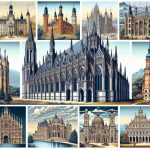
To really get into Polish culture, you need to dive into the traditions and items that make it special.
Wearing traditional Polish clothes gives you a taste of the country’s history.
Then there’s the folk art and crafts, which are just beautiful to look at.
Don’t forget about the food – Polish dishes are delicious and there’s so much variety.
Listening to Polish music is a great way to feel the celebratory vibe, and reading about the history and symbols gives you a deeper understanding of what they mean.
These things are not just objects or activities; they help keep Polish culture alive and tell the story of the country.
Let’s talk about it in a way that’s easy to grasp and feels like we’re just having a chat.
Traditional Polish Attire
Polish culture is rich and diverse, and a significant part of this cultural tapestry is the traditional attire that varies across different regions of Poland. Each piece of clothing tells a unique story with its patterns, colors, and designs, reflecting the local traditions and communal identities.
For men, a standout piece is the goral vest, a woolen garment featuring detailed embroidery that showcases the wearer’s highlander heritage. It’s often paired with a felt hat, completing a look that’s both traditional and symbolic of pride. Women’s traditional clothing is equally striking, particularly noted for its use of vibrant floral motifs. One of the most beautiful accessories for women is the ‘wianki’ or flower crowns, which represent youth and beauty. These costumes are not just clothing but a celebration of Polish history and community ties, crafted with great care and attention to detail.
The significance of these traditional costumes goes beyond mere appearance. They play a crucial role in preserving Polish culture, allowing it to be shared with and appreciated by future generations. By wearing these garments during cultural festivals and celebrations, Poles keep their heritage alive, fostering a sense of unity and continuity.
If you’re interested in experiencing Polish culture firsthand, trying on traditional Polish attire or attending a cultural festival could be a great start. Not only would it be a unique experience, but it would also offer a deeper understanding of the country’s traditions and values. For those looking to own a piece of this rich cultural heritage, there are artisans and shops that specialize in traditional Polish clothing and accessories, offering authentic and beautifully crafted items.
Folk Art and Handicrafts
Poland’s culture shines brightly through its folk art and handicrafts. These pieces are not just for show; they tell the story of Poland’s history and social changes. For example, the pottery from Bolesławiec stands out with its unique white and blue patterns. Each piece is a result of skilled craftsmanship passed down through generations, reflecting the region’s identity. Similarly, the fine lace from Koniaków is a testament to delicate artistry, showcasing a deep-seated tradition in the area.
Wooden sculptures are another important aspect of Polish folk art. These often represent rural life or religious figures, highlighting the strong bond between the Polish people and their land. This connection is not only spiritual but also deeply rooted in everyday life, as seen in the themes of these artworks.
By buying these handicrafts, you’re not just getting a unique piece of art. You’re also helping to keep Poland’s cultural heritage alive. Supporting local artisans ensures that these traditions don’t fade away but continue to thrive and evolve. Whether it’s a piece of pottery, lace, or a wooden sculpture, you’re owning a part of Poland’s rich cultural tapestry.
In a nutshell, Polish folk art and handicrafts are more than just beautiful objects. They’re carriers of history, tradition, and identity. Each piece is a bridge to the past, offering a glimpse into the lives and values of those who came before. So, next time you’re looking for something special, consider one of these handicrafts. Not only will you be adding a unique touch to your home, but you’ll also be part of preserving a rich cultural legacy.
Polish Culinary Delights
Poland’s culinary scene is a vibrant reflection of its cultural richness, showcasing a variety of dishes that reveal the country’s gastronomic history. Among these, pierogi stand out as a versatile dish, with fillings ranging from the classic potato and cheese to more exotic options like wild mushrooms or fruits. This dumpling has become synonymous with Polish cuisine, demonstrating the country’s ability to create complex flavors from simple ingredients.
Another essential Polish dish is bigos, a robust stew made with sauerkraut and various meats. The process of slow-cooking bigos allows the flavors to meld together, resulting in a deeply satisfying dish that’s both aromatic and hearty. It’s a perfect example of Poland’s tradition of making nourishing meals that can feed a crowd, emphasizing the communal aspect of dining.
Żurek, a sour rye soup, is another staple, highlighting the Polish skill in turning basic components into delicious and memorable meals. The tanginess of the fermented rye pairs wonderfully with the richness of the added meats, making żurek a unique and beloved dish within the Polish culinary repertoire.
In discussing these dishes, it’s clear that Polish cuisine values the transformation of simple ingredients into complex flavors, a testament to its historical and cultural depth. Whether it’s the versatile pierogi, the hearty bigos, or the unique żurek, each dish invites diners to explore Poland’s rich culinary landscape. For those looking to experience this cuisine firsthand, seeking out authentic Polish restaurants or trying your hand at these recipes at home are great ways to dive into Poland’s food culture.
Celebratory Polish Music
Music plays a crucial role in Polish celebrations, reflecting the country’s rich heritage and history through its melodies and rhythms. In Poland, traditional music often includes instruments like the accordion and violin. One interesting instrument that might be new to some is the hurdy-gurdy, which adds a unique sound to the mix. These instruments are typically part of the music accompanying traditional dances such as the mazurka and polonaise, both of which hold significant places in Poland’s cultural identity.
Modern Polish celebrations might mix these traditional music elements with contemporary genres, showing how Polish music has adapted over time. This blend of old and new creates a vibrant musical landscape. For example, at local festivals, you might encounter folk ensembles that bring traditional Polish music to life. On a larger scale, national events could feature grand orchestras that highlight the sophistication and depth of Polish musical heritage.
The variety of music in Poland is a testament to the country’s ability to honor its past while also embracing new influences. This approach makes Polish music an essential part of cultural celebrations, connecting people to their history and each other. Whether it’s through a lively dance at a local festival or a grand performance on a national stage, Polish music brings people together, celebrating the nation’s journey through its captivating sounds.
In a nutshell, Polish music, with its mix of traditional and modern elements, plays a vital role in celebrations, reflecting the nation’s evolving culture while staying rooted in its history.
Historical Literature and Symbols
Music is a key part of Poland’s cultural identity, but the country’s history, literature, and symbols also play a huge role. For example, the writings of Adam Mickiewicz and Henryk Sienkiewicz aren’t just books. They’re important pieces of Polish culture that show the country’s spirit and determination. Mickiewicz’s ‘Pan Tadeusz’ and Sienkiewicz’s ‘Quo Vadis’ help us understand what it means to be Polish. They mix history with stories in a way that makes people proud of where they come from.
The White Eagle, Poland’s national symbol, is another crucial part of this. It stands for Poland’s long fight for freedom and independence, something that is very meaningful to the Polish people. If you want to get a good feel for Polish culture, you can’t skip over these parts. They show us Poland’s past and how it continues to shape the country today.
In a more straightforward way, these elements of Polish culture – the literature of Mickiewicz and Sienkiewicz, along with the symbol of the White Eagle – are like windows into the soul of Poland. They help anyone interested in understanding what makes Poland unique and how its rich history and traditions continue to influence its people. By engaging with these works and symbols, you’re not just learning about Poland; you’re getting to know it on a deeper level.
Conclusion
Wrapping up, getting into Polish culture with its traditional clothes, unique folk art, tasty food, lively music, and historic books is a great way to truly get what Poland’s heritage is all about.
These things aren’t just cool symbols of national pride; they also help us connect with Poland’s deep history and its colorful traditions.
By adding these essential items to your celebrations, you can get closer to Polish culture, making sure it stays alive and relevant even in today’s global scene.






Comments are closed.